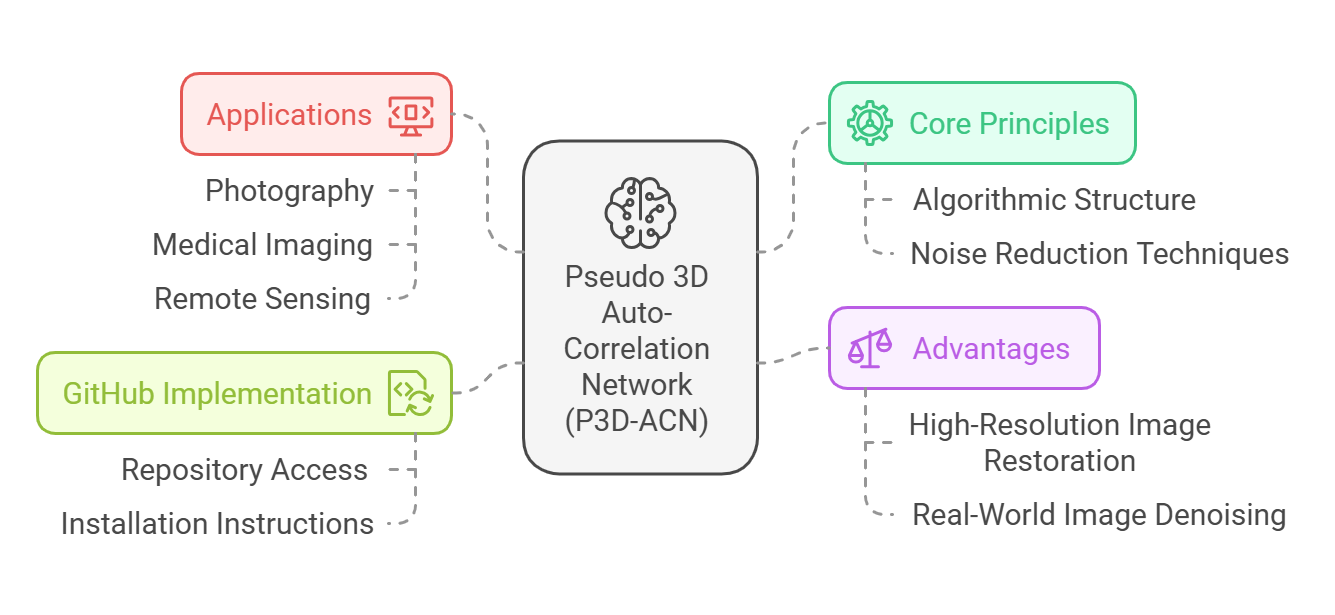Explore the Pseudo 3D Auto-Correlation Network (P3D-ACN) for real image denoising. Learn about its features, applications, GitHub implementation, and advantages for reducing noise in real-world images.
Pseudo 3D Auto-Correlation Network for Real Image Denoising
Image denoising has emerged as one of the most critical tasks in modern computer vision. The increasing prevalence of high-resolution images and videos across various domains, such as photography, medical imaging, and remote sensing, has further amplified the need for robust denoising algorithms. Among the numerous innovations in this field, the pseudo 3D auto-correlation network (P3D-ACN) has recently gained significant attention for its ability to effectively restore noisy real-world images. In this article, we delve into the core principles, advantages, and potential applications of the P3D-ACN while focusing on its GitHub implementation for researchers and developers.
What is a Pseudo 3D Auto-Correlation Network (P3D-ACN)?
The pseudo 3D auto-correlation network introduces an innovative approach to image denoising by leveraging the concept of pseudo 3D convolution combined with auto-correlation mechanisms. Unlike traditional 2D convolutional neural networks (CNNs) that operate on spatial information in a single dimension, the P3D-ACN models spatial and contextual dependencies across multiple dimensions. This enables it to better understand the underlying patterns in images, especially when dealing with complex noise.
The term “pseudo 3D” stems from the design of its convolutional layers. Instead of processing data purely in three dimensions, P3D-ACN uses separable operations along spatial and contextual axes. This not only reduces computational overhead but also maintains a high level of accuracy.
Key Features of Pseudo 3D Auto-Correlation Networks
- Multi-Dimensional Contextual Modeling: By extending traditional 2D convolutions to pseudo 3D, the network captures correlations between adjacent pixels more effectively.
- Auto-Correlation Mechanism: Inspired by signal processing techniques, auto-correlation layers improve the network’s ability to focus on repetitive patterns in noisy data, helping to preserve fine details while removing unwanted distortions.
- Real-Image Optimization: Unlike synthetic noise models, P3D-ACN is tailored for real-world scenarios where noise patterns are more complex and less predictable.
- Lightweight Architecture: Despite its advanced features, the P3D-ACN maintains a compact design that allows it to run efficiently on GPUs and even edge devices.
- Open-Source Availability: The availability of P3D-ACN implementations on GitHub makes it accessible for researchers, developers, and enthusiasts to experiment and build upon.
Advantages of P3D-ACN for Real Image Denoising
The P3D-ACN outperforms conventional denoising methods in several ways:
- Higher Accuracy: Its ability to model spatial and contextual dependencies leads to superior noise removal and image quality preservation.
- Scalability: The pseudo 3D architecture is adaptable to various image resolutions and noise levels.
- Reduced Computational Cost: By avoiding full 3D convolutions, the network achieves impressive results without requiring excessive hardware resources.
- Generalizability: It performs well across different types of noise, including Gaussian, Poisson, and real-world camera noise.
- Integration Potential: The lightweight design makes it suitable for integration into existing pipelines and mobile applications.
Applications of Pseudo 3D Auto-Correlation Networks
- Photography: Enhancing the quality of images taken in low-light or high-noise conditions.
- Medical Imaging: Removing noise from X-rays, MRIs, and CT scans to improve diagnostic accuracy.
- Remote Sensing: Denoising satellite imagery to enhance environmental monitoring and urban planning.
- Surveillance: Improving the clarity of footage captured by security cameras in challenging conditions.
- Augmented Reality (AR) and Virtual Reality (VR): Optimizing visuals for immersive user experiences.
GitHub Implementation of P3D-ACN
The official GitHub repository for Pseudo 3D Auto-Correlation Networks provides:
- Source Code: Python implementations based on popular deep learning frameworks like PyTorch or TensorFlow.
- Pretrained Models: Ready-to-use models trained on benchmark datasets for real image denoising.
- Documentation: Comprehensive guides for setup, training, and inference.
- Datasets: Links to publicly available datasets used for training and evaluation.
- Community Contributions: Opportunities to collaborate, submit issues, and suggest improvements.
To access the repository, visit the P3D-ACN GitHub page and follow the instructions provided for installation and usage.

GitHub Spring Boot Conducting Unit Testing Without Restarting Applications
How to Get Started with P3D-ACN
- Clone the Repository: Use Git to clone the official repository onto your local machine.
git clone https://github.com/username/p3d-acn
-
Install Dependencies: Ensure that all required libraries and dependencies are installed.
pip install -r requirements.txt
- Load Pretrained Models: Download and load pretrained models for quick evaluation.
- Run Inference: Use sample scripts to test the network on noisy images.
- Fine-Tune for Custom Datasets: Train the model on your own dataset for domain-specific denoising tasks.
FAQs
1. What makes P3D-ACN better than traditional denoising methods? P3D-ACN’s pseudo 3D architecture and auto-correlation layers enable it to capture complex spatial and contextual dependencies, resulting in superior noise reduction.
2. Is the P3D-ACN implementation available on GitHub free to use? Yes, the official GitHub repository is open-source and free for personal and research purposes.
3. Can P3D-ACN handle real-world noise effectively? Absolutely. The network is specifically optimized for real-world noise patterns, making it suitable for practical applications.
4. What datasets are supported for training the P3D-ACN? The network can be trained on publicly available datasets such as SIDD, DND, and customized datasets.
5. How computationally expensive is P3D-ACN? The lightweight pseudo 3D architecture ensures efficient performance, even on GPUs with limited memory.

